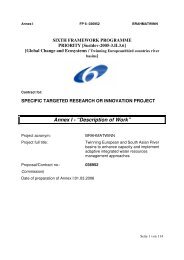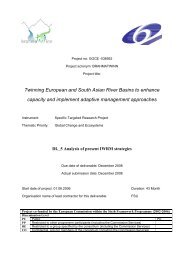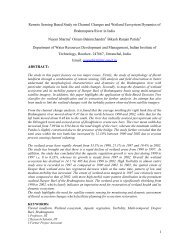4. Lasut 2005 Creative thinking - Brahmatwinn
4. Lasut 2005 Creative thinking - Brahmatwinn
4. Lasut 2005 Creative thinking - Brahmatwinn
Create successful ePaper yourself
Turn your PDF publications into a flip-book with our unique Google optimized e-Paper software.
Evolving evaluation matrix will emerge after the methodology tests, now designed as a matrix<br />
structured of questions, which participants are evaluating in point scale.<br />
3.2 Stakeholders’ consultations<br />
For eliciting stakeholders preferences, the most suitable technique within the NetSyMod<br />
approach is the Hodgson’s hexagon’s technique because it is relatively simple to be<br />
explained and understood by the group, it emphasises the causal links and ranking the<br />
concepts by colour coding that aids visualising the key ideas and problems.<br />
In the previous phases of the NetSyMod the advisable pre-workshop stages are conducted in<br />
which each member of the team is interviewed briefly on his/her initial reactions to the<br />
subject, and through open-ended questioning the first layer of deeper thought is mapped. After<br />
the facilitator introduces the main themes, the ‘issue conceptualisation’ (understanding of the<br />
problem) follows. The stakeholders are then given a number of hexagonal cards and they<br />
themselves provide the concepts using movable hexagons for capturing data. With the help<br />
and guidance of the facilitator, participants group the hexagons. Facilitator provokes<br />
exploration of alternative, more adventurous grouping. Relationships are indicated by the<br />
‘influence diagrams’ with arrows connecting those clustered ideas that are causally related<br />
and a sign attached to the arrow states if the influence is positive or negative. Then feedback<br />
loops can be created. At any time in the process, blank hexagons can be added to the existing<br />
clusters in order to capture newly generated ideas. Then different clusters are linked by ‘core<br />
ideas’ (initially blank hexagons). Concepts might be colour coded in the same way as it was<br />
described in the previous section providing colour balance to ideas . Furthermore, the<br />
exercise could result in an output which may be crucial to the wider utilisation of modelling,<br />
namely a ‘dynamic representation’ of the model. In this case the ‘idons’ (combination of idea<br />
and icon) are manipulated, combined and rearranged as a continuous process of formulating<br />
thoughts.<br />
4 Conclusions<br />
The main output of the CSM exercise either with experts of stakeholders is the cognitive map<br />
(a model). Although cognitive mapping places less emphasis on the formal structure of the<br />
decision space model, a well conducted map building session should lead to a model with a<br />
structure that can be analysed in a variety of ways (Eden C., Ackermann F. and Cropper S.,<br />
1992). This includes feedback loop analysis, which can be performed on the whole model or<br />
just a subset. Cognitive commitment to the action plan is achieved through developing shared<br />
understanding between participants, and emotional commitment through participation in the<br />
workshop process (Eden C. 1992).<br />
The model emerging from the CSM exercise provides qualitative and/or quantitative<br />
indicators to be used as inputs and further modified in the design of DSS tools. More<br />
specifically, the elicited knowledge allows a more informed and accurate undertaking of the<br />
Conceptual phase in mDSS, where problem identification, identification of alternatives to<br />
address the problem take place; and in the Choice phase, where the evaluation, normalisation<br />
and weighting of the multidimensional data take place. In the case of experts’ consultations,<br />
the CSM could also lead to a quantification of the indicators, not only their selection. For<br />
participatory modelling with stakeholders, the quantification of the selected indicators will, on<br />
the other hand, be done by the researchers’ team during the final phases of NetSyMod.<br />
12





